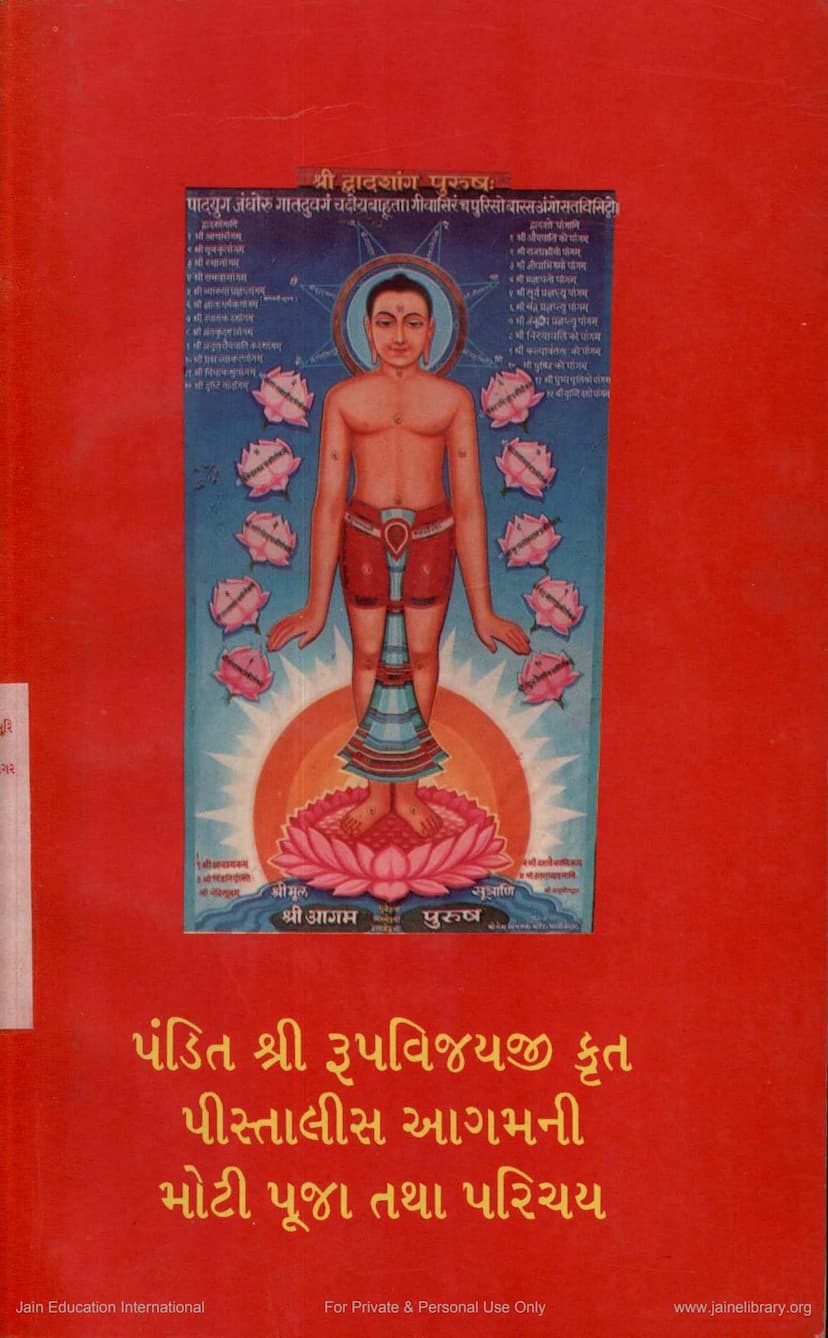Pistalisa Agam Pooja Tatha Parichay
Added to library: September 2, 2025

Summary
This document is a comprehensive guide to the "Pistalisa Agam Pooja tatha Parichay" (Worship and Introduction of Forty-Five Agamas), authored by Pandit Shri Rupvijayji and published by Shrutgyan Prasarak Sabha. The book serves as a devotional manual for performing puja (worship) of the forty-five Jain Agamas, considered the sacred scriptures of Jainism.
Here's a breakdown of the content:
1. Introduction and Purpose:
- The book highlights the importance and tradition of performing Agam Pooja, which involves revering and worshipping the Agamas as the words of the Tirthankaras (enlightened beings).
- It mentions the joy and spiritual upliftment experienced by attendees during such pujas, emphasizing the profound impact of the devotional songs and the arrangement of the Agamas.
- The third edition of this book is published due to the enthusiastic requests from devotees who wished to continue the practice of chanting the Agam Pooja.
2. Rituals and Procedures for the Pooja:
- Preparation: The puja begins with Snatra (a ritual bath).
- Placement of Agamas: All forty-five Agamas are to be respectfully placed before the deity.
- Offerings: For each Agama, the ritual involves offering five types of fruits, five types of naivedya (food offerings), 45 coconuts, 45 betel leaves with areca nut, and 45 lamps.
- Eight-Fold Worship: While the thali (plate of offerings) for one Agama is being chanted, an eight-fold worship (ashtaprakari pooja) of the main deity should be performed, accompanied by lighting a lamp.
- Process: The devotee should stand by the Agama whose puja is currently being performed. After the puja for each Agama is completed, it is to be honored with vasakshep (colored rice), gold coins or silver coins, rice, flowers, incense, lamps, naivedya, and fruits.
- Mantra Chanting: After each puja, the specific mantra (chant) associated with that Agama should be recited 108 times.
- Grand Finale: Upon completion of all forty-five Agamas' pujas, a grand aarti (worship with lamps) of 108 lamps, a mangal deep (auspicious lamp), and a shanti kalash (peace pot) are performed.
- Two-Day Puja: If the puja is conducted over two days, the first 23 Agamas are worshipped on the first day, and the remaining 22 on the second. The seven-lamp aarti is performed on the first day.
3. Detailed Pooja for Each Agama: The book then proceeds to detail the pooja for each of the forty-five Agamas. For each Agama, it provides:
- Sanskrit Name: The name of the Agama in Sanskrit.
- Serial Number: A sequential numbering of the Agamas.
- Doha (Couplet): A brief devotional couplet summarizing the essence or importance of the Agama.
- Dhal (Metrical Verse): A devotional song or pado in Gujarati, set to a specific tune (deshi), describing the content or significance of the Agama. The verses often praise the Tirthankaras and the Agamas themselves, urging devotees to worship them for spiritual liberation.
- Mantra: A specific mantra for worshipping the Agama, usually invoking Lord Jinendra and the specific Agama.
4. The Forty-Five Agamas: The document systematically lists and describes the pooja for each of the forty-five Agamas, which can be broadly categorized into:
-
Eleven Angas (Primary Scriptures):
- Shri Acharanga Sutra
- Shri Suyagadaanga Sutra
- Shri Sthanaanga Sutra
- Shri Samavayanaanga Sutra
- Shri Vyakhyaprajnapti (Bhagavati) Sutra
- Shri Jnatadharmakathananga Sutra
- Shri Upasakadashanga Sutra
- Shri Antakritadashanga Sutra
- Shri Anuttaraupapatadashanga Sutra
- Shri Prashnavyakaranaanga Sutra
- Shri Vipakaanga Sutra
-
Twelve Upangas (Secondary Scriptures): 12. Shri Oovai (Aupapatika) Sutra 13. Shri Raypasenai (Raiyapaseni) Sutra 14. Shri Jivabhigama Sutra 15. Shri Pannavna (Pannavna) Sutra 16. Shri Surya Prajnapti Sutra 17. Shri Jambudveepa Prajnapti Sutra 18. Shri Chandra Prajnapti Sutra 19. Shri Nirayavalika Sutra 20. Shri Kalpakashika Sutra 21. Shri Pushpit Sutra 22. Shri Pushpalika Sutra 23. Shri Vanidasha Sutra
-
Ten Chudashaka (Groups of Ten): These include various treatises on different aspects of Jain philosophy, conduct, and cosmology. Examples include: 24. Shri Chau-sarana Panna 25. Shri Aaur Pachakkhan Panna 26. Shri Mahapachakkhan Panna 27. Shri Bhattaparijna Panna 28. Shri Nandulaleya Panna 29. Shri Ganividya Panna 30. Shri Chandravijay Panna 31. Shri Devendrastava Panna 32. Shri Maranasamadhi Panna 33. Shri Santhara Panna
-
Four Mula Sutras (Root Scriptures): 34. Shri Dashashrutaskandha Sutra 35. Shri Brihatkalpa Sutra 36. Shri Vyavahara Sutra 37. Shri Jita Kalpa Sutra 38. Shri Nishitha Sutra 39. Shri Mahanishitha Sutra 40. Shri Aavashyak Sutra 41. Shri Dashavaikalika Sutra 42. Shri Uttaradhyayana Sutra 43. Shri Pinda Niryukti Sutra 44. Shri Nandi Sutra 45. Shri Anuyogadvara Sutra
5. Content of Specific Agamas (Brief Descriptions): Towards the end of the book, there are brief descriptions of many of the listed Agamas, providing their general subject matter, key figures or concepts they discuss, and sometimes their approximate number of verses or commentaries. This section offers a glimpse into the vastness and depth of the Jain Agamas.
6. Materials for Pooja: The appendix lists the extensive materials required for performing this elaborate puja, including:
- Manuscript copies of the Agamas.
- Various cloths (rumals, sapdas).
- Idols or representations of the Agama Purusha.
- Fruits, coconuts, naivedya.
- Spices, incense, camphor, saffron.
- Flowers, sandalwood, rice, holy water.
- Gold and silver flowers, decorative items.
- Utensils for offerings (plates, bowls, pots).
- Worship accessories like lamps, aarti plates, fans, mirrors.
- Decorative elements for the puja space.
- Provisions for musicians, sound systems, lighting, and stage setup.
- Specific requirements for each day if the puja is conducted over multiple days (e.g., milk, yogurt, garlands).
In essence, "Pistalisa Agam Pooja tatha Parichay" is a devotional text that not only guides the ritualistic worship of the forty-five Jain Agamas but also provides a foundational understanding of their significance within the Jain tradition. It emphasizes devotion, adherence to scripture, and the spiritual benefits derived from such practices.